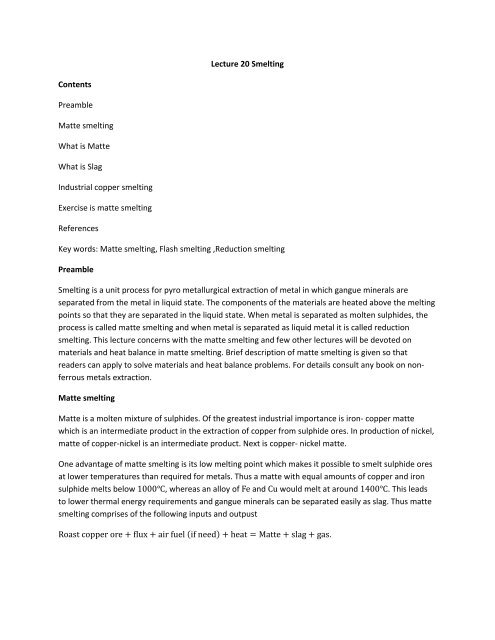Lecture 20 Smelting Contents Preamble Matte smelting What ... - nptel
Lecture 20 Smelting Contents Preamble Matte smelting What ... - nptel
Lecture 20 Smelting Contents Preamble Matte smelting What ... - nptel
You also want an ePaper? Increase the reach of your titles
YUMPU automatically turns print PDFs into web optimized ePapers that Google loves.
<strong>Contents</strong><br />
<strong>Preamble</strong><br />
<strong>Matte</strong> <strong>smelting</strong><br />
<strong>What</strong> is <strong>Matte</strong><br />
<strong>What</strong> is Slag<br />
Industrial copper <strong>smelting</strong><br />
Exercise is matte <strong>smelting</strong><br />
References<br />
<strong>Lecture</strong> <strong>20</strong> <strong>Smelting</strong><br />
Key words: <strong>Matte</strong> <strong>smelting</strong>, Flash <strong>smelting</strong> ,Reduction <strong>smelting</strong><br />
<strong>Preamble</strong><br />
<strong>Smelting</strong> is a unit process for pyro metallurgical extraction of metal in which gangue minerals are<br />
separated from the metal in liquid state. The components of the materials are heated above the melting<br />
points so that they are separated in the liquid state. When metal is separated as molten sulphides, the<br />
process is called matte <strong>smelting</strong> and when metal is separated as liquid metal it is called reduction<br />
<strong>smelting</strong>. This lecture concerns with the matte <strong>smelting</strong> and few other lectures will be devoted on<br />
materials and heat balance in matte <strong>smelting</strong>. Brief description of matte <strong>smelting</strong> is given so that<br />
readers can apply to solve materials and heat balance problems. For details consult any book on non‐<br />
ferrous metals extraction.<br />
<strong>Matte</strong> <strong>smelting</strong><br />
<strong>Matte</strong> is a molten mixture of sulphides. Of the greatest industrial importance is iron‐ copper matte<br />
which is an intermediate product in the extraction of copper from sulphide ores. In production of nickel,<br />
matte of copper‐nickel is an intermediate product. Next is copper‐ nickel matte.<br />
One advantage of matte <strong>smelting</strong> is its low melting point which makes it possible to smelt sulphide ores<br />
at lower temperatures than required for metals. Thus a matte with equal amounts of copper and iron<br />
sulphide melts below 1000 , whereas an alloy of Fe and Cu would melt at around 1400 .<br />
This leads<br />
to lower thermal energy requirements and gangue minerals can be separated easily as slag. Thus matte<br />
<strong>smelting</strong> comprises of the following inputs and outpust<br />
Roast copper ore flux air fuel if need heat <strong>Matte</strong> slag gas.
<strong>What</strong> is <strong>Matte</strong><br />
<strong>Matte</strong> as described<br />
earlier isusually a molten mixture of iron and copper sulphides. Minor amounts of<br />
other sulphides may be present, Copper grade of matte is important. Whenever matte grade is given in<br />
the problem, it means copper grade and is defined as<br />
Amount of Cu in matte<br />
Cu grade 100<br />
Amount of Cu S FeS<br />
Assuming that matte consists of Cu S and eS in copper <strong>smelting</strong>. Density of matte is 5 to 5.5 cm F<br />
⁄ and<br />
melting point depends on proportion of CuSFeS and may range in between 1100 1<strong>20</strong>0.<br />
<strong>What</strong> is a Slag<br />
mixture of mainly oxides and unreduced sulphides. Limestone or lime id added as a flux.<br />
Slag usually consists of SiO,AlO,CaO,CuO,FeO,FeOand FeO. Density of slag is 2.8 3.8g cm Slag is a molten<br />
⁄ .<br />
Industrial copper <strong>smelting</strong><br />
Roast concentrate is heated in a reverberatory furnace. It is a long hearth furnace, covered with a roof<br />
and heated by combustion of oil or powdered coal.<br />
The furnace is charged with hot pre roasted calcine or with wet flotation concentrate. Silica is added to<br />
flux FeO and to give a suitable slag. In some plants line or limestone is also added. The molten matte is<br />
tapped from tap holes along the middle of the furnace, whereas slag is tapped from the flue gas end of<br />
the furnace. The temperature is kept about 1<strong>20</strong>0. Hot gases carry sufficient amount of heat and are usually passed<br />
through a steam<br />
boiler before then go to gas cleaning and discharge.<br />
Copper content of slag is about 0.3 0.6%<br />
In flash <strong>smelting</strong> finely ground ore, together with flux is introduced through a suitable burner. The matte<br />
and slag sink whereas the furnac e gases are removed through the off take. In flash <strong>smelting</strong> preheated<br />
air or pure oxygen is used to produce required amount of heat.<br />
In most cases sufficient heat is generated by oxidation of FeS. Low grade concentrate contains more<br />
FeS. Flash <strong>smelting</strong> combines both roasting and <strong>smelting</strong>.<br />
Exercise in matte <strong>smelting</strong><br />
1) a) In a copper ore chalcopyrite is 34%, Pyrite 30%and SiO 36%. Determine the% of copper,<br />
iron and sulphur<br />
b) <strong>What</strong> would be the % gangue in a chalcocite ore if the copper content is same as in 1a)? The<br />
ore contains CuS.
Solution:<br />
c) <strong>What</strong> would be the entire % composition of matte containing 38% copper when the matte is<br />
expressed by fo<br />
the rmulamCu S. nFeS?<br />
a) % Cu 11.83%<br />
b) % gangue is 85.21<br />
A C<br />
c) 0.38 <br />
A CSA FS<br />
Formula<br />
is CuS. 2FeS<br />
% Fe 24.35%<br />
% S 27.83%<br />
<br />
128m<br />
160m 88n<br />
m<br />
n<br />
0.5<br />
2)<br />
If a copper ore containing 34%chalcopyrite, 30% FeS and 36% SiO is fused down and only<br />
excess sulphur<br />
is eliminated, what would be the matte grade?<br />
References for the lectures <strong>20</strong> to 25<br />
% Cu<br />
<strong>Matte</strong> grade 100<br />
% Cu S % FeS<br />
22.2%<br />
1. Ray, H.S; Sridhar, R and Abraham, K.P: Extraction of non ferrous metals.<br />
2. Rosenquist : Principles of extractive metallurgy<br />
3. Butts, Allison: Metallurgical Problems,<br />
McGraw Hill Book Company, 1943
















